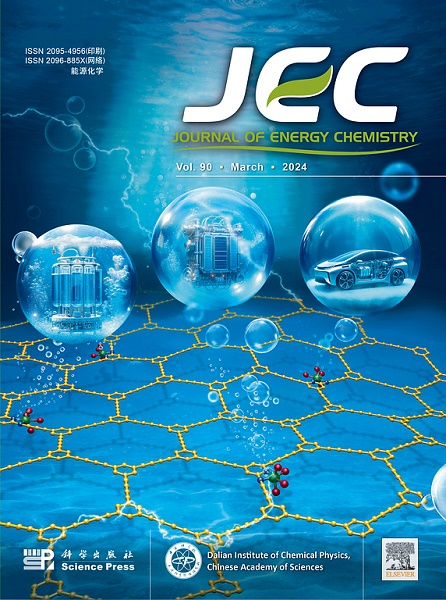Tailoring the electrolyte microenvironment of indium catalysts for enhanced formic acid electrosynthesis
IF 13.1
1区 化学
Q1 Energy
引用次数: 0
Abstract
Electrocatalytic carbon dioxide reduction reaction (CO2RR) to formic acid is considered an economically viable avenue toward carbon neutrality. Indium-based catalysts have garnered considerable attention in CO2RR owing to their elevated hydrogen evolution reaction (HER) overpotential and eco-friendly characteristics. We have synthesized In2O3 nanofibers rich in oxygen vacancies using the electrospinning technique. The resultant 500-In2O3 exhibited superior performance in converting CO2RR to HCOOH, achieving an impressive formate Faradaic efficiency (FE) of 92.1% at a current density of −600 mA cm−2. Moreover, it demonstrated remarkable stability, maintaining its performance over 100 h at a current density of −300 mA cm−2 under a neutral electrolyte. Density functional theory (DFT) calculations, in conjunction with spectroscopic characterizations, have revealed that a Cl-modified In catalyst exhibits a lowered energy barrier for the formation of *HCOOH, while simultaneously inhibiting the generation of *H, in contrast to its pristine In counterpart. Ultimately, we successfully engineered a dual-electrode system capable of simultaneously producing formate at both the cathode and the anode. At a current density of −100 mA cm−2, our system achieves a reduction in energy consumption by 12.5% and a significant enhancement in electrical energy conversion efficiency by 39.9%.

调整铟催化剂的电解质微环境以提高甲酸电合成能力
本文章由计算机程序翻译,如有差异,请以英文原文为准。
求助全文
约1分钟内获得全文
求助全文
来源期刊

Journal of Energy Chemistry
CHEMISTRY, APPLIED-CHEMISTRY, PHYSICAL
CiteScore
19.10
自引率
8.40%
发文量
3631
审稿时长
15 days
期刊介绍:
The Journal of Energy Chemistry, the official publication of Science Press and the Dalian Institute of Chemical Physics, Chinese Academy of Sciences, serves as a platform for reporting creative research and innovative applications in energy chemistry. It mainly reports on creative researches and innovative applications of chemical conversions of fossil energy, carbon dioxide, electrochemical energy and hydrogen energy, as well as the conversions of biomass and solar energy related with chemical issues to promote academic exchanges in the field of energy chemistry and to accelerate the exploration, research and development of energy science and technologies.
This journal focuses on original research papers covering various topics within energy chemistry worldwide, including:
Optimized utilization of fossil energy
Hydrogen energy
Conversion and storage of electrochemical energy
Capture, storage, and chemical conversion of carbon dioxide
Materials and nanotechnologies for energy conversion and storage
Chemistry in biomass conversion
Chemistry in the utilization of solar energy
 求助内容:
求助内容: 应助结果提醒方式:
应助结果提醒方式:


